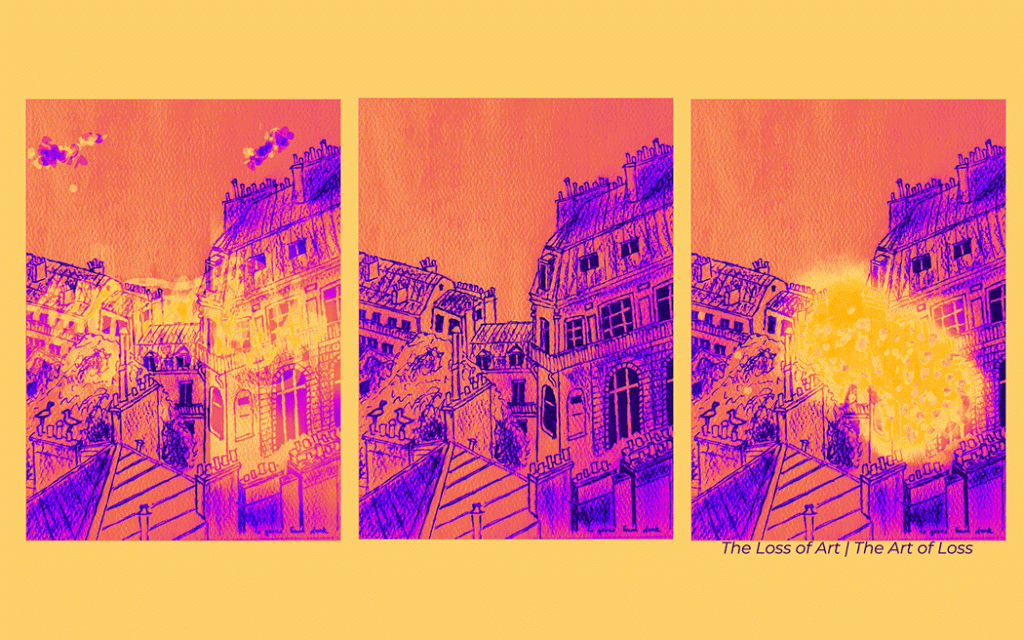
The Visual Spectrums Collaborative Arts Project, a traveling exhibit that explores art for all eyes to enjoy, comes to Fairfield on Friday, November 7, at the Fairfield CoLab, 101 N. Court St., 6:00-10 p.m., during Fairfield First Fridays. The exhibit will also be making stops at other venues across Eastern Iowa.
When the idea originally hit me to create a visual arts exhibit for people like me—people with vision loss, I brushed the thought aside as an impossible ideal, a crazy dream. I had given up on the visual arts many years earlier, when at age 20 I developed an autoimmune eye condition and watched my visual world erode away. I concluded that anything having to do with the visual could no longer apply to me, the nonvisual.
Once I relegated myself to the nonvisual world, I encouraged myself to forget how, when I was younger and had spotless vision and the horizon was mine to see, I was in love with art. I liked sketching best. I liked using charcoal and paper to make the real world seem even more real by distilling it into one essential moment. I also reveled in other artists and art museums, and how one look at another person’s work could change my perception forever.
But the further away I got from art, the more it tried to revisit me. Art references and metaphors crept into my thoughts and writing, and old images of my beloved Magrittes lingered like ghosts desperate to reclaim their rightful place. So last summer, when I heard about the Big Field Fund grants (to support projects that manifest new and inventive models in the visual arts), the idea of writing a proposal to create Art for the Blind flared into life. Like art, it refused to leave my mind, until one day the idea didn’t seem so implausible after all.
The Visual Spectrum
Blindness, like light and life, falls on a spectrum. Visual impairment comes in many forms, and seeing less is not seeing nothing. And at its essence, art is more than vision; it is a communion of expression that changes our experience of the world for the better. Perhaps I, and people like me, could embrace art as a way to reengage with an experience thought to be lost, to redefine what blindness truly means, and to build a community that fosters hope and healing through collaborative creation. So in the end I wrote my proposal for Art for the Blind, and in late 2024 it was selected as one of the winners in the inaugural year of the Big Field Fund.

Thus, the Visual Spectrums project was born. Collaborative creation was central to my proposal, and I immediately joined creative forces with my friend Cheryl Weatherford, a talented wire sculptor, metaphysical stone artist, and art teacher from Iowa City. Cheryl is a longtime believer in the power of art to transcend the conflicts and losses that make up this life. Together we searched for and found a core collaborative group of artists and art appreciators excited to create a small, public, “visually inclusive” arts exhibit. As a group, we began exploring how visual works and exhibition spaces might be able to reach people of all kinds of visual abilities, such as using touch, sound, and even smell to convey the essence of a visual arts piece.
Visual Diversity
Lately, as our group prepares to debut the Visual Spectrums exhibit to the public, I keep thinking that I have greatly underestimated the power of collaboration. Throughout the year, as I met our artists and heard them describe their own unique visual experiences—experiences that other people might perceive as challenges—I came to fully understand just how diverse the visual spectrum is. And as I listened to our artists enthusiastically share about their art, their processes, and their ways of viewing the world, I saw where I really have lost my sight over the years.
For a long time, I have thought of my eyes as broken and of myself as unwhole. Somehow, while watching our artists at work, I suddenly felt open to seeing myself in a new light, as part of a unique group of diverse, passionate, creative souls. I went from thinking of our project as one of visual inclusivity and visual accessibility to one of visual diversity. I hope that as this work continues, it gives many people a chance to see with new eyes.
To learn more about, join, or contribute to the Visual Spectrums Collaborative Arts Project, visit VisualSpectrums.org. Follow Visual Spectrums on Facebook and Instagram.
Support for this work is provided by Big Field Fund, a program of Public Space One. Funding is provided by the Andy Warhol Foundation for the Visual Arts. Engman and Weatherford extend a special thank-you to the Big Field Fund and Public Space One for believing in the project and providing the initial funding to get it off the ground.
